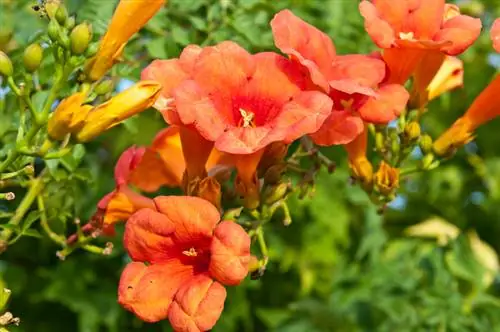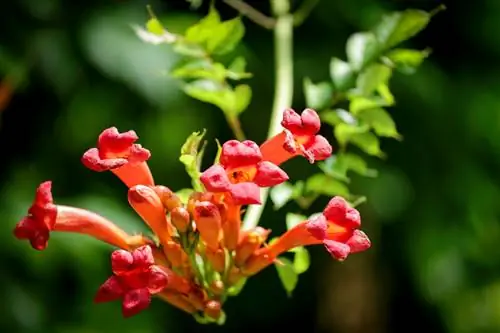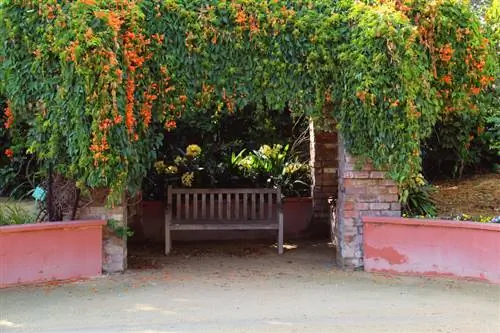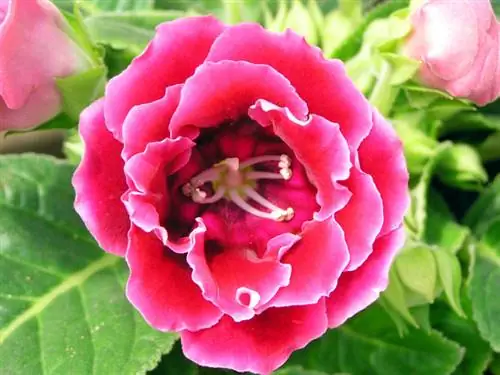- Author admin [email protected].
- Public 2023-12-16 16:46.
- Last modified 2025-06-01 06:02.
The climbing trumpet or trumpet flower (Campsis) can be grown as a ground cover or tied to a wall as a climbing plant; it needs sun and nutrient-rich soil. The quickest way to propagate is through cuttings, but it's not that easy.
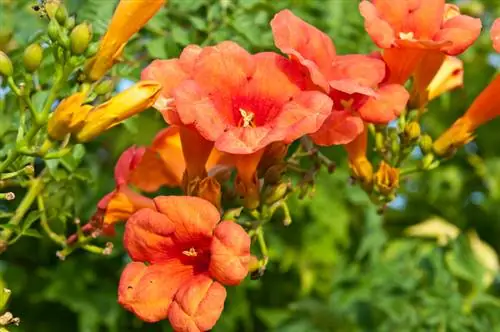
How do you properly care for a climbing trumpet?
To properly care for the climbing trumpet, it needs a sunny location with a shady root area, nutrient-rich, moist soil, regular watering, moderate fertilization, annual pruning and, if necessary. Winter protection. Please note that all parts of the plant are poisonous and wear gloves when working.
Which location does the trumpet flower prefer?
Trumpet flowers like it warm, protected and sunny, although the “foot” - i.e. the root system - should be in the shade. A sunny spot on a house wall that radiates heat is perfect.
Which soil conditions are ideal for the climbing trumpet?
The plant needs nutrient-rich, moist soil, as in its homeland it is mainly found in moist swampy areas and has difficulty coping with drought. However, permanent wetness or waterlogging should be avoided.
Can the climbing trumpet also be cultivated in a pot?
Although the climbing trumpet needs a lot of moisture, it cannot tolerate waterlogging. For this reason, you should ensure good drainage in the pot.
How often should the trumpet flower be watered?
The climbing trumpet cannot tolerate longer dry periods, so you should water the plant regularly, making sure the soil is well moistened each time. It also makes sense to mulch the root area, as this prevents the soil from drying out.
When and with which fertilizer can I fertilize the climbing trumpet?
In principle, it is enough to provide planted climbing trumpets with a little compost (€12.00 on Amazon) to sprout. Nitrogen-containing fertilizer should be used very sparingly, as it stimulates growth but prevents flowering.
When and how is the trumpet flower pruned?
Since the climbing trumpet only produces its flowers on young shoots, the plant should be cut back heavily in spring - ideally between February and March. Thin, weak or too long branches can also be cut off all year round - the plant mainly flowers on short branches.
When does the climbing trumpet bloom?
The trumpet flower - depending on the variety - usually blooms between July and October.
My climbing trumpet isn't blooming, why is that?
If the climbing trumpet does not bloom, it could be due to a location that is too shady. In addition, the plants only bloom when they are around four years old.
How can I propagate trumpet flowers?
Climbing trumpets reproduce very reliably through seeds and root runners. You can specifically propagate the plants by sowing, planting or cuttings.
Is the climbing trumpet susceptible to certain diseases and pests?
The plant is less susceptible to pest or disease infestation.
Is the climbing trumpet hardy?
The American climbing trumpet (Campsis radicans) is hardy down to minus 15 °C, while the more sensitive Chinese climbing trumpet (Campsis grandiflora) is quite sensitive to frosty temperatures. Winter protection is therefore always appropriate.
Tip
Since all parts of the climbing trumpet are poisonous, you should always wear gloves when working in the garden.

